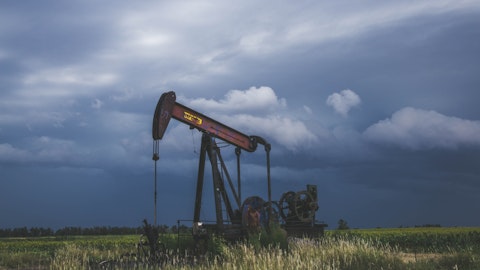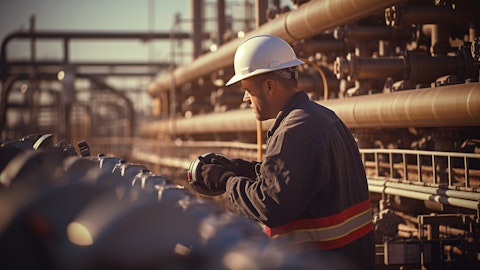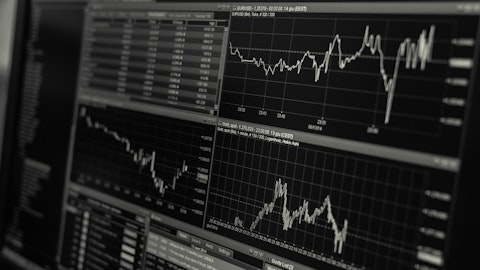There is a lot of actions to be able to do what we can control or fix what we can control. The margins aren’t great. I mean, that’s obvious, and I don’t know how long that lasts. But what we have to be able to do is to do the best that we can within the constraints that we have, and so we are focused on that. We also haven’t changed the guidance that against the indicative chemical margin that we presented in Capital Markets Day. We expect to deliver around $3 billion to $4 billion of earnings coming out of the chemicals and products portfolio. So that’s where we are and there is no shortage of attention nor effort to be able to get this to be the best business that it can be within the constraints of what the business is today, while we continue to look at options to do even better.
Sinead, would you have one to add anything?
Sinead Gorman: I think one sentence would be, you’re completely right. It is loss making at this point in time and that’s why you can see my confidence and our confidence as we talk about the free cash flow into the future of the company, by stopping that loss-making side of things, by turning it around, by doing the divestments, by getting Monaca up and running. It just gives us that runway, Lucas, into the future in terms of being able to just see that free cash flow growth. I think you have covered it all.
Wael Sawan: Thank you very much, Lucas, for the question. Luke, can we go to the next question, please?
Operator: Our final caller today is Jeoffrey Lambujon from TPH & Co.
Jeoffrey Lambujon: Hi, everyone, and thanks for squeezing me in. My first is a follow-up on one of the projects you mentioned earlier, LNG Canada. Could you provide a status update their whether in terms of completion and start-up timelines or however you’d characterize it as you see things today? And then my second question is on the structural cost reductions, which as you mentioned are already well in flight following a strong 2023. I know you referenced that this is going to be an ongoing initiative even beyond the 2025 timeframe that bounds the near-term target. But could you comment on how you’re thinking about sources for and timeline of deliverability for these reductions over the near-term, just at least as far as the visibility that you have and can share. Thank you.
Wael Sawan: Thank you very much, Jeoffrey. I will take the first one and then, let Sinead address the second one. LNG Canada, you will have, we also addressed this last year. We have seen, of course, Coastal GasLink pipeline completed mechanically last year and ready and available to ramp up through the course of 2024. The facility itself at Kitimat is now just over 90% complete as per the report from the joint venture. So, they’re making good progress. And we would expect that later this year, they would start up the commissioning of the plant. That, of course, takes several months, well into 2025. But it’s comforting to see the progress that is being made. And of course, once we start producing those commissioning cargoes will be made available from day one to our foundational customers as you would expect.
So, pleased with the progress, but this is no doubt, this is a very, very complex facility that’s going to be ramped up. And therefore, we are going to be — to watch it and to support the team as they do that through the course of the coming 12 months to 18 months.
Sinead Gorman : And thanks, Jeoffrey. You asked about OpEx. You heard me talk about how pleased I am in terms of the progress to date, $1 billion after only seven months. Great progress. We talk about it in terms of where we play and how we play. In terms of where we play, the portfolio moves on the predominance of that at the moment. And you can see, of course, is ramping up with Pakistan coming through Nigeria coming through and many others that you will see flow through as well. So, you’ll see some of the OpEx come down. The reason I don’t give you timing on that is, of course, it’s dependent on approvals and when that will actually occur. So, we expect those to happen towards the back end of this year, more than likely 2024.
The higher we play, that’s a difficult stuff, that’s the bottoms up. very much in terms of three areas I’d look at, Leaner Corporate Center, Wael already alluded to IT and taking out contingent workers there, but across all of the functions, making sure it’s fit for purpose. We, of course, look at it in terms of pacing the growth in terms of our downstream and res business. They’re really going after things while talked about chemicals, et cetera, and the thoughts of taking costs out there. But of course, also, you see it in terms of low carbon fuels where we’ve got this mixture of actual growth coming through with Natural energy but of course, moving away from some of the aspects of hydrogen into mobility in California as an example. So, you’ll see a bit of a mix there.
And finally, we’re looking at continued improvement, of course, in our upstream business, where you see the aspects of going after hard where we spend money in terms of maintenance, making sure it’s really bang for our buck, et cetera. So those ones you will see come through in the course of the year, but the big meaty ones will be probably towards the end of the year. What I hope you’re seeing on all of this is, we’ve given you a promise in terms of $2 billion to $3 billion. We’re already $1 billion through there. So indeed, it’s a wide performance rather than the promises, and we’re really continuing to drive that hard.
Wael Sawan : That’s a great way to end. Jeoffrey, thank you for the questions. And hopefully, the theme of today you would have taken is this is a company that is truly delivering now on its print and we are building the track record that we said we want to build. Thank you all for your questions. Thank you for joining the call. Wishing you all a very pleasant end of the week. Thank you for your time.





